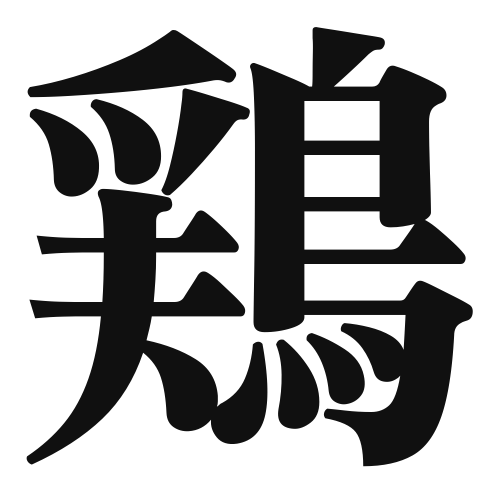1. Overview of Meaning
The kanji “鶏” (pronounced “niwatori” in Japanese) means “chicken.” It refers to the domesticated bird commonly raised for its meat and eggs. In a broader sense, it can also represent poultry in general.
2. Formation and Radical
Formation of the Kanji: The kanji “鶏” is a compound character, which is a type of phonetic-ideographic character. It combines the radical for “bird” (鳥) with the phonetic component “圭,” which contributes to its pronunciation.
Radical: The radical of “鶏” is 鳥 (tori), which means “bird.” This radical is commonly found in kanji related to birds and flying creatures.
3. Examples of Usage
Common Words and Phrases:
- 鶏肉 (にわとりにく, niwatori niku) – chicken meat
- 鶏卵 (けいらん, keiran) – chicken egg
Example Sentences in Daily Conversation:
- 今晩は鶏肉を料理します。 (こんばんはにわとりにくをりょうりします。) – I will cook chicken meat tonight.
- 朝ごはんに鶏卵を食べました。 (あさごはんにけいらんをたべました。) – I ate a chicken egg for breakfast.
4. Synonyms and Antonyms
Similar Kanji:
- 鳥 (とり, tori) – bird (a more general term that includes all types of birds, not just chickens).
Antonyms:
- 獣 (けもの, kemono) – beast (referring to animals that are not birds, often used for mammals).
5. Cultural and Historical Background
Relation to Japanese Culture: Chickens have been an important part of Japanese agriculture and cuisine. They are often featured in traditional dishes and festivals.
Proverbs and Idioms: One common saying is “鶏口となるも牛後となるな” (けいこうとなるもぎゅうごとなるな), which translates to “Better to be the head of a chicken than the tail of an ox,” meaning it is better to be a leader in a small group than a follower in a large one.
